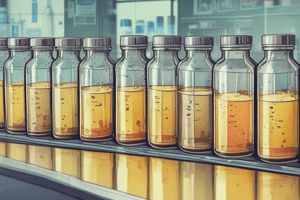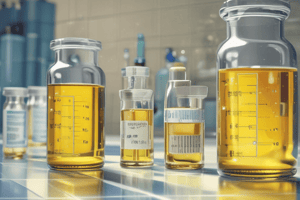Podcast
Questions and Answers
What is a primary benefit of using Thymol in urine preservation?
What is a primary benefit of using Thymol in urine preservation?
- It increases the pH of the sample.
- It reduces the volume of the sample.
- It inhibits bacteria and fungi. (correct)
- It enhances the color of the urine.
Which of the following is NOT a physical examination characteristic of urine?
Which of the following is NOT a physical examination characteristic of urine?
- Volume
- Clarity
- Presence of glucose (correct)
- Color
What could cause urine to appear brown in color?
What could cause urine to appear brown in color?
- Increased protein intake
- High bilirubin levels
- Severe dehydration (correct)
- Excessive hydration
What does a pale yellow to an amber color in fresh urine primarily indicate?
What does a pale yellow to an amber color in fresh urine primarily indicate?
Which condition could lead to the appearance of red urine?
Which condition could lead to the appearance of red urine?
What medication is known to potentially cause orange-colored urine?
What medication is known to potentially cause orange-colored urine?
What is one potential cause of urinary incontinence?
What is one potential cause of urinary incontinence?
Which biochemical test is NOT typically performed during urinalysis?
Which biochemical test is NOT typically performed during urinalysis?
What is a potential cause of blue-green urine?
What is a potential cause of blue-green urine?
Which condition is characterized by high levels of pus or white blood cells in the urine?
Which condition is characterized by high levels of pus or white blood cells in the urine?
What does the presence of milky or cloudy urine most likely indicate?
What does the presence of milky or cloudy urine most likely indicate?
Which of the following conditions can lead to polyuria?
Which of the following conditions can lead to polyuria?
What urinary volume is considered abnormal in oliguria?
What urinary volume is considered abnormal in oliguria?
Which treatment or procedure could possibly cause blue urine?
Which treatment or procedure could possibly cause blue urine?
Which factor is NOT typically associated with variations in urine volume?
Which factor is NOT typically associated with variations in urine volume?
Which of the following conditions is LEAST likely to cause white (milky) urine?
Which of the following conditions is LEAST likely to cause white (milky) urine?
What component is NOT typically found in normal urine?
What component is NOT typically found in normal urine?
Which method is preferred for routine urinalysis?
Which method is preferred for routine urinalysis?
What effect does room temperature have on urine if it remains unprocessed for more than 2 hours?
What effect does room temperature have on urine if it remains unprocessed for more than 2 hours?
What is a primary indication for performing a urinalysis?
What is a primary indication for performing a urinalysis?
Which urine preservation method is recommended for up to 8 hours?
Which urine preservation method is recommended for up to 8 hours?
What can occur due to bacterial proliferation in unprocessed urine?
What can occur due to bacterial proliferation in unprocessed urine?
Which chemical preservative is used specifically to preserve adrenal hormones in a 24-hour urine sample?
Which chemical preservative is used specifically to preserve adrenal hormones in a 24-hour urine sample?
What happens to glucose levels in urine if it remains unprocessed for more than 2 hours?
What happens to glucose levels in urine if it remains unprocessed for more than 2 hours?
Flashcards
What is urinalysis?
What is urinalysis?
Urine analysis is a laboratory test that examines the physical, chemical, and microscopic properties of a urine sample.
What are the components of normal urine?
What are the components of normal urine?
Cells, crystals, casts, debris, and microorganisms.
Why is first morning urine preferred for urinalysis?
Why is first morning urine preferred for urinalysis?
First morning urine is preferred for routine urinalysis because it's more concentrated and contains higher levels of analytes.
What is a clean-catch urine sample?
What is a clean-catch urine sample?
Signup and view all the flashcards
What happens to urine left at room temperature?
What happens to urine left at room temperature?
Signup and view all the flashcards
How can urine be preserved?
How can urine be preserved?
Signup and view all the flashcards
Which preservative is used for adrenaline, noradrenaline, and steroids?
Which preservative is used for adrenaline, noradrenaline, and steroids?
Signup and view all the flashcards
What does toluene do in urine preservation?
What does toluene do in urine preservation?
Signup and view all the flashcards
Urochrome
Urochrome
Signup and view all the flashcards
Urinary Incontinence
Urinary Incontinence
Signup and view all the flashcards
Amber Urine
Amber Urine
Signup and view all the flashcards
Orange Urine
Orange Urine
Signup and view all the flashcards
Brown Urine
Brown Urine
Signup and view all the flashcards
Red Urine (Hematuria)
Red Urine (Hematuria)
Signup and view all the flashcards
Boric Acid
Boric Acid
Signup and view all the flashcards
Formalin
Formalin
Signup and view all the flashcards
What causes blue or green urine?
What causes blue or green urine?
Signup and view all the flashcards
What condition can cause green urine?
What condition can cause green urine?
Signup and view all the flashcards
What can cause milky or cloudy urine?
What can cause milky or cloudy urine?
Signup and view all the flashcards
What is chyluria?
What is chyluria?
Signup and view all the flashcards
What is pyuria?
What is pyuria?
Signup and view all the flashcards
What is the normal urine output per day?
What is the normal urine output per day?
Signup and view all the flashcards
What is polyuria?
What is polyuria?
Signup and view all the flashcards
What is oliguria?
What is oliguria?
Signup and view all the flashcards
Study Notes
Urinalysis Overview
- Urinalysis is a procedure for examining urine to diagnose or monitor medical conditions.
Normal Urine Composition
- Cells: Red blood cells (RBCs), white blood cells (WBCs), epithelial cells, renal cells
- Crystals: Uric acid, bilirubin, calcium oxalate
- Casts: Granular, cellular, hyaline
- Debris: Hair, crystals from powders
- Microorganisms: Bacteria, Trichomonas vaginalis
Indications for Urinalysis
- Suspected renal diseases (e.g., glomerulonephritis, nephrotic syndrome, pyelonephritis, renal failure)
- Detection of urinary tract infections (UTIs)
- Detection and management of metabolic disorders (e.g., diabetes mellitus)
- Differential diagnosis of jaundice
- Detection and management of plasma cell dyscrasias
- Diagnosis of pregnancy
Urine Collection Methods
- First morning urine (midstream): Preferred for routine urinalysis
- Random urine (midstream): Routine urinalysis
- First morning urine (midstream); clean catch: Bacteriological examination
- Post-prandial: Estimation of glucose, urobilinogen
- 24-hour urine: Quantitative estimation of proteins or hormones
- Catheterized: Bacteriological examination in infants, bedridden patients, and urinary tract obstructions
Effects of Room Temperature on Urine
-
Increased pH: Due to ammonia production from urea by urease-producing bacteria
-
Crystal formation: Precipitation of phosphates and calcium (turbidity)
-
Ketone loss: Ketones are volatile
-
Decreased glucose: Glucose is used by cells and bacteria
-
Bilirubin oxidation: False negative test for bilirubin
-
Urobilinogen oxidation: False negative test for urobilinogen
-
Cellular disintegration: Especially in alkaline and hypotonic urine
-
Bacterial proliferation
Urine Sample Preservation
- Refrigeration (4-6°C): Best method for up to 8 hours
- Hydrochloric acid: Preservation for 24-hour urine samples (adrenaline, noradrenaline, steroids)
- Toluene: Physical barrier for bacteria and air; used for measuring biochemicals
- Boric acid: General preservative
- Thymol: Inhibits bacteria and fungi
- Formalin: Excellent for preserving formed elements
Performing Urinalysis
- Physical examination: Color, clarity, volume
- Biochemical testing: Leukocytes, nitrite, ketone, pH, specific gravity, blood, urobilinogen, protein, glucose, bilirubin
- Microscopy
Physical Examination - Color
-
Pale yellow/straw color: Healthy
-
Dark yellow/amber: Dehydration
-
Orange: Dehydration, liver issues, certain foods/medications
-
Brown: Liver issues, dehydration, blood, porphyria, certain conditions, infections
-
Red: Blood in urine, certain foods/medications, certain medical conditions
-
Blue/green: Unusual; rare conditions or medications
-
White/milky: Dehydration, diabetes, chyluria, infections, or other conditions.
-
Urine volume: Average output in 24 hours 600-2000 ml; can vary based on intake, climate, diet
-
Abnormal urine volume (Polyuria, Oliguria, Anuria): Conditions that can cause these include diabetes, congestive heart failure, acute glomerulonephritis, or other conditions.
-
Clarity: Clear, slightly cloudy, cloudy, turbid
-
Odor: Aromatic (freshly voided), ammonia (standing urine), fruity, fishy, foul, or other odors based on specific medical conditions
Urine Sample Preparation - Mixing of Sample
- Mix urine thoroughly using a figure 8 pattern for even distribution of components and sediments (bacteria, crystals, casts, parasites, epithelial cells, white blood cells, fungi) before analysis.
Urine Biochemical Testing
- Reagent strips: Used for quick detection of various substances in the urine
- Detailed tables for specific biochemical tests, including normal ranges and clinical significance, are needed.
Studying That Suits You
Use AI to generate personalized quizzes and flashcards to suit your learning preferences.




